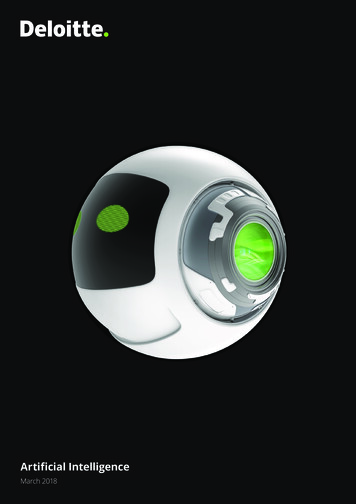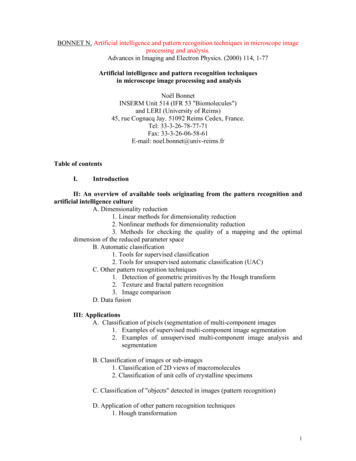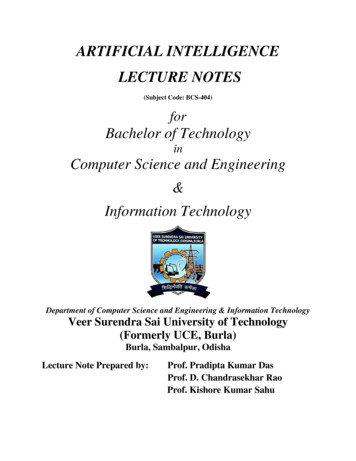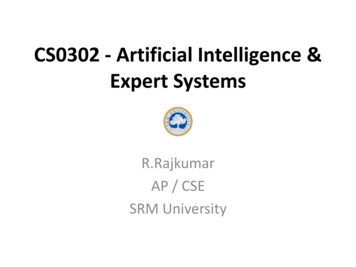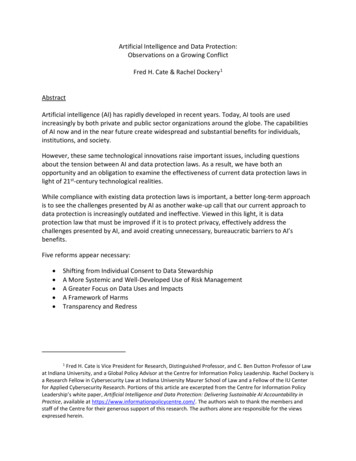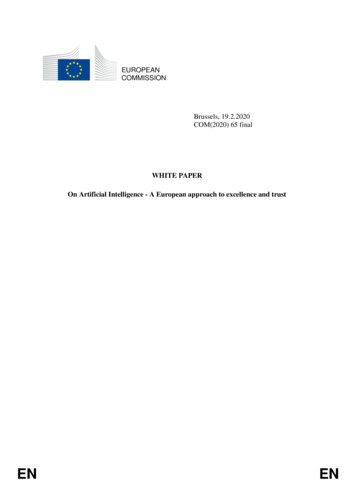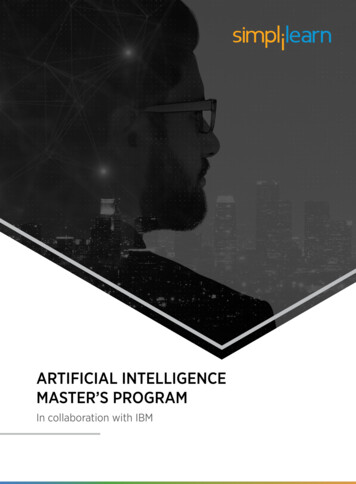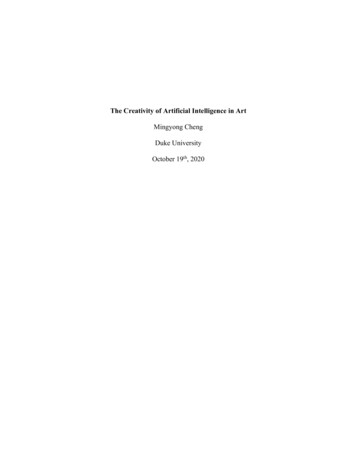
Transcription
The Creativity of Artificial Intelligence in ArtMingyong ChengDuke UniversityOctober 19th, 2020
AbstractNew technologies, especially in the field of artificial intelligence, are dynamic in transformingthe creative space. AI-enabled programs are rapidly contributing to areas like architecture,music, arts, science, and so on. The recent Christie's auction on the Portrait of Edmond hastransformed the contemporary perception of A.I. art, giving rise to questions such as thecreativity of this art. This research paper acknowledges the persistent problem, "Can A.I. art beconsidered as creative?" In this light, the study draws on the various applications of A.I., variedattitudes on A.I. art, and the processes of generating A.I. art to establish an argument that A.I. iscapable of achieving artistic creativity.1
Table of ContentsChapter One . 41.1 Introduction . 42.1 Overview . 72.2 Defining Artificial Intelligence . 82.3 Application of AI in Various Fields . 102.3.1 Music . 102.3.2 AI in Visual Arts . 142.4 Attitudes on Artwork and AI . 172.4.1 Transforming Jobs . 182.4.2 AI Assistants . 192.4.3 The Wave of AI-based Art . 212.4.4. Controversy: The Portrait of Edmond . 232.5 Research Questions . 28Chapter Three: Discussion . 303.1 AI-Generated Painting . 303.1.1 The Schema Theory . 303.1.2 Computers are Social Actors (CASA) . 323.2 Generative Adversarial Networks (GAN) . 333.2.1 GAN’s Theory . 333.2.2 Implementing GAN into Art . 353.2.3 Difference between the Current and Traditional GAN . 373.2.4 Popular GAN Artists . 383.3 Creative Adversarial Network (CAN) . 403.3.1 CAN Artistic Works . 42Chapter Four . 454.1 Could AI Achieve Human-level Creativity? . 454.1.1 Human Creativity and Machine Creativity . 454.2 What are the values/features of AI Creativity? . 484.2.1 Combinatory Creativity . 484.2.2 Explanatory Creativity . 494.2.3 Transformational Creativity . 504.3 What is the Essence of AI Art? The Potential in AI Technology . 51Chapter Five . 535.1 Conclusion . 53Bibliography . 552
Table of FiguresFigure 1: The Portrait of Edmond . 24Figure 2: AI art created by the artists, Robbie White, Tom White, Anna Ridler and MarioKlingemann . 26Figure 3: Controversy on Obvious’ Code . 27Figure 4: The Framework Applied in the Generator . 34Figure 5: Framework utilized in the discriminator . 35Figure 6: “79530 Self Portraits,” . 38Figure 7: “Barrat’s Landscape Painting series” . 39Figure 8: The Nudes Series . 40Figure 9: “Faceless Portrait of a king” . 42Figure 10: “Faceless Portrait of a queen” . 42Figure 11: “Faceless Portrait of a general”. 43Figure 12: “Faceless Portrait of a pope” . 43Figure 13: Animal shapes imagined and created by Deep-dream . 513
Chapter One1.1 IntroductionNew technologies, and especially those that involve artificial intelligence, aredynamically transforming the state of creativeness. Computers are assuming very profoundpositions in creation: music, science, fine arts, and architecture. However, this paper suggeststhat we should focus on a broader association of computers and creativity. Instead of recognizingthe computer as a tool to aid human creators, it could be viewed as a creative embodiment in itsown light. This view has borne a new concept of artificial intelligence – computational creativity.As a result, this paper communicates the prospect of accomplishing computational creativitythrough the application of certain computer programs, which can replicate specific concepts ofartistic behavior.For everything one imagines, there is a possibility of realizing it. According to Oscar,“Human creativity is the only machine that never stops creating things. But could ArtificialIntelligence become creative?”1 Besides, Kurt suggested that science entails whatever wecomprehend quite enough to elaborate to a computer and art entails all the things we do in thatregard: “science advances whenever an art becomes science” 2. For this paper, we dive into thetransition and evolution of science and art, in which artworks are constructed using algorithms1Oscar GR, "Artificial Intelligence. The New Creative AI," Medium, last modified August 5,2020, gence-the-new-creative-ai-8d0c4dd7d0a52D. E. Kurt, "Artistic Creativity in Artificial Intelligence," (PhD diss., Radboud University,Netherlands, 2018), 8769680668e908d443412598cf9cf.4
rather than by paintbrushes. Through this symbiotic relationship, this paper regardscomputational creativity as an exploration avenue of the evolving interaction of machine andhuman intelligence.The likelihood of accrediting human abilities to a machine is a philosophical dilemmathat intrigued the mind ever since the first interaction with tools – the thinking machine? Thistimeline dates back to the 5th century BC, to The Iliad which is known, encompassed withwritten literature and complemented with automata of the Greek god Hephaestus and the womanPandora. Ever since, scientists and philosophers have struggled to respond to the question ofwhether the human mind could be computed or if it can be realized in other forms. Thesequestions act as the basis of artificial intelligence in art.Presently, Artificial Intelligence is a concept that is evolving in various areas of our lives,especially with the ever-evolving technology. Because computer technology has significantlyevolved since the 20th century, the study on Artificial intelligence and its limitless abilities haverisen to be the primary focus of discussion. The primary exploration about computers: if they cando things done by humans, has risen to be the most significant question of our era. Thisexploration has a special place in the art and creative world. When the machines beganproducing artworks, they changed to be creative producers. From been imaginary themes inutopian literature and science fiction plays, the machines have become the producers of thispieces of writing and movies.Thus, their input in the creative industry has dynamically changed. Although artificialintelligence and utilization in arts has been a significant topic for years, its popularity andacceptance has heightened in recent years. Artificial intelligence’s popularity in artistic creationshighlights the new art genre. However, the credibility of this art genre and the aspect of creation5
are still enigmatic concepts that require intensive academic and practical investigation. Since thestandard elaboration of art assesses this notion as a form of communication between individuals,new investigation that engage AI art requires supplementary strategies to the aspect of artisticwork, to define a category of AI art. With this focus, this research paper investigates if machinescan illustrate artistic abilities, and if this illustrative process is creative in itself.Additionally, even if a creative process exists, are its results artistic, and if so, how is itassociated with human-centered creativeness? As the great works of Paul Valery affirm “wemust expect great innovations to transform the entire technique of the arts, thereby affectingartistic invention itself and perhaps even bringing about an amazing change in our very notion ofart” 3. With the rise of artistic machines and computing software, this transition in the aspect ofart is becoming more visible. Besides the aspect of art itself, the inclusion of art-maker and theartwork is all together a new avenue of study that needs intense consideration.In reference to Valerie, this research paper will attempt to offer an academic approachinto the works of art in this era of mechanical manipulation and creation. Computed arts,machine intelligence, generative art, and algorithmic art that are generated using equal systemsgive rise to the question, can Artificial Intelligence be regarded as a generative art?3Razieh Rahmani, "Ceci N’est Pas une Ford T: Art and Reproduction inRagtime," Critique:Studies in Contemporary Fiction 58, no. 2 (2016): 80, doi:10.1080/00111619.2016.1158143.6
Chapter Two2.1 OverviewIn order to understand Artificial Intelligence (AI), as this research’s primary goal, it isessential to begin by analyzing human intelligence and its constructs. The Oxford Dictionarydefines artificial intelligence as “the theory and development of computer systems able toperform tasks normally requiring human intelligence such as visual perception, speechrecognition, decision making, and language translation”4. From this definition, it is evident thathuman intelligence is the backbone and AI’s culmination. The term ‘intelligence’ conveysthinking while ‘artificial’ conveys computational operations. The most intriguing and widelyassessed entails “AI’s ability to think like a human”5.This chapter intents to introduce the topic of AI and associated concepts: What is a‘machine’ based on computational operations, and ‘thinking’ based on machines? Under whatcircumstances can a machine be referred to as intelligent? By highlighting these questions anddesigning a discussion on the likelihood of achieving human-related abilities on machines, thechapter will attempt to suggest a transition from intelligence to creativity. Because creativity isconclusive in intelligence, AI-related discussions should be based on the illustration of humanenabled machines, mirrored with human intelligence.4Angus Stevenson Oxford Dictionary of English (New York: Oxford University Press, USA,2010).5Kurt "Artistic Creativity in Artificial Intelligence,” 8.7
2.2 Defining Artificial IntelligenceKurt described the concept using McCarthy’s interpretation, “the science and engineeringof making intelligent machines, especially intelligent computer programs”6 . According toMcCarthy, the concept of intelligence is grounded on the computational abilities to meet specifictargets. This explanation work for both humans and machines. As Brinson argues, the world isyet to get to the point in which intelligence can be independently interpreted without relying onhuman intelligence7. Besides, it is still a challenge to point out computational systems that can beevaluatively termed as intelligent. As McCarthy indicate, there are various concepts ofintelligence that are yet to be comprehended8.To answer the question of whether machines can think, Alan Turing – considered as oneof AI’s father - explored the concepts -machines and thinking9. In Turing’s evaluation onmachine intelligence, he failed to address a conceptual variation between human and machine.Turing’s denial or incapability to define a variation, he postulated the idea that it is challenging6Kurt “AI,” 9.7S. Brinson, "How Will Artificial Intelligence Impact the Art World?" Artzine, last modified2020, ntelligence-impact-the-art-world8John McCarthy, "What is Artificial Intelligence? How Does AI Work?" Tech News, Trends &Professional Development Resources Built In, last modified 2007, https://builtin.com/artificialintelligence.9Jaime Zornoza, "The History of Artificial Intelligence: The Turing Test," Medium, lastmodified May 14, 2020, ficial-intelligence-theturing-test-c1d6777d2970.8
to state a distinction since machines are human-born. Hence, to get to a solid and precisecomprehension of the definitions, Turing proposed the ‘Imitation Game.’ This game aimed atassessing the outcome in which a machine took part in a human-related role; basically, is amachine capable of manipulating a human observer into believing that it is also a real human?Consequently, the Turing Test is essential in the present day’s query and navigation of AI as itexplores the possibility in which a machine can emulate humanly abilities. Moreover, the testoffers a precise comprehension of machine and human association.McCarthy10 and Kurt proposed that the aspect of intelligence is composite, thus it isimpossible to use either a yes or no to the inquiry “is this machine intelligent?”11 . McCarthydescribed that intelligence engage numerous approaches that machines can handle, and that thosethey are incapable of performing12. Further, he postulated that today’s computational programscan to some extent, be acknowledged as quite intelligent. It could be implied that the literature onhuman intelligence is still in its underway evaluation. Hence, studying AI simultaneously offersmore comprehension on human intelligence.In this light, it is appropriate to suggest a parallel between the studies on AI and cognitiveassessment on the human brain. AI studies are co-linked with studies that intend to applycomputers to comprehend human intelligence; however, Kurt clarifies that AI need not impounditself on methodological procedures that are biologically assessible13.10John McCarthy, “What is Artificial Intelligence.”11Kurt, “Artificial Intelligence,” 12.12John McCarthy, “What is Artificial Intelligence?”13Kurt, “Artificial Intelligence.”9
2.3 Application of AI in Various FieldsNew technologies, especially artificial intelligence, are dynamic in transforming the stateof creative processes. Computers are significantly contributing to creative roles like architecture,music, fine arts, science, and so on. Apparently, computers are already musical appliances, paintbrushes, and canvas. However, various studies have aimed at achieving a wilder interactionbetween creativity and computers. Instead of perceiving computers as mere instruments to aidhuman creators, they perceive it as a creative entity. This perception has activated a new segmentof AI – computational creativity. In order to assess the various fields that are applying AI forartistic evolution, this paper focuses on the question of the viability of accomplishingcomputational creativity via particular computer programs that replicate some constructs ofcreative artistic actions. The discussed fields will augment the recent trends of creativityenhanced by human creativity.2.3.1 MusicAI has contributed to computer music since its advent in the 1950s. However, mostemphasis has been put on compositional and improvisational mechanisms, but little focus hasbeen on expressive performance. This sub-section assesses various success in AI mechanizationto music, with a larger focus on expressive performance.Music Composition10
The works of Hiller and Isaacson using an ILLIAC computer pioneered computermusic14. The work’s outcome was the ILLIAC suite, which is a string quartet developed using agenerate and test algorithm. The suite produced notes pseudo-randomly, while applying Markovchains. These notes were later assayed using heuristic compositional basics. The notes wereretained based on their compliance on the basics, but if none of the notes were found to becompliant, they were backtracked and a new cycle was initiated. Hiller and Isaacson’s results didnot include aspects of expressiveness and emotionality. In a cross examination, the twocomposers indicated that before they could address the concept of expression, they needed totackle simpler challenges related to composition. Their observation was relevant in the 1950setting because it compelled other researchers to use Markov probability to enhance melodicquality. However, their findings were not so conclusive because consistency was not achieved.Consequently, Levitt dismissed the application of probabilities in his composing process.He claimed that “randomness tends to obscure rather than reveal the musical constraints neededto represent simple musical structures”15. Thus, his works relied on constraint-based musicaldescriptions. He designed a descriptive language that enabled the expression of meaningfulmusical transformations, like melodic lines and chord enhancement via style templates. Throughthis approach, Levitt managed to describe contemporary jazz player and piano simulations.14R. L. Lopez de Mantaras, "Artificial Intelligence and the Arts: Toward ComputationalCreativity," in The Next Step: Exponential Life (Spanish National Research Council (CSIC),Bellaterra, Spain: Bbva-Open Mind, 2017).15R. L. Lopez de Mantaras, "Artificial Intelligence and the Arts: Toward ComputationalCreativity," 5.11
Music Expression and PerformanceOne of the main drawbacks of computer-composed music is in inadequateexpressiveness, or gesture. Musicians rely on gesture to illustrate unique and subtly descriptiveor creative performances. The first attempt to illustrate expressiveness entailed the creations ofJohnson16. She designed an expert program to assess the tempo and articulations to be used whenperforming Bach’s Fugues. The program’s rules were extracted from two human performers. Theoutput produced base tempo variables and basics on notes’ duration. However, Johnson’s systemhad a limitation since it lacked generality as the fugues were developed on a 4/4 value. Besides,the lack of generality illustrated that the program’s rules would only apply to the Bach Fugues.The success achieved by Stockholm’s KTH group indicated one of the long-lastingefforts on expressive performance17. Their recent system weaves in basics for tempo,articulation, and dynamic transformations confined to MIDI. The basics are deduced both fromempirical musical knowledge and practicality through training, especially utilizing the analysisby-synthesis methodology. The basics were put in two categories: differential basics, whichaugment the distinction between scale tones; grouping basics that indicate the relatable tones;and ensemble basics that synchronize voices into a quartet.With a case-associative reasoning, Lopez de Mantaras illustrated the possibility ofhandling five most critical expressive constructs: rubato, articulation, dynamics, vibrato, and16R. L. Lopez de Mantaras, "Artificial Intelligence and the Arts.”17R. Bresin, "Articulation Rules for Automatic Music Performance," Academia.edu - ShareResearch, last modified 2001,https://www.academia.edu/930545/Articulation rules for automatic music performance.12
manipulation of ones18. To achieve expressiveness, his proposed system applies a case memorywith descriptive human performances, investigated using spectral modelling methods and a basicmusical knowledge. Also, the performance’s score is provided by the proposed system. Theprimary goal of the method is to assess the notes’ input determining (using basic musicalknowledge) its effect on the musical phrase it is intended, clarify and extract (using the basis ofhuman performance) notes with equal effects, and change the notes’ input so that the notes’expressive constructs replicate the similarly extracted notes. Every note in the human-based caseis elucidated with its effect on the musical phrase it is intended, as well as with the note’sexpressive constructs. Besides, the notes not only have information about every note, but theyalso entail contextual information at the notes’ phrase. Thus, the system’s cases have ambiguousobject-centered illustrations.Laetitia Sonami, an artist known for her sound and composition artistic expertise, appliesAI using the Lady’s Glove19. Her performances entail the computational creativity exhibited bythe Lady’s Glove, which she designed to activate and manipulate sound during performances.Moreover, Sonami develops sound creation works by integrating household machinesencompassed with mechanical and electrically ingrained compounds. According to the artist, theglove came to be from a joke conceived by technology, only to evolve into an instrument. In aninterview, she affirmed that,18R. L. Lopez de Mantaras, "Artificial Intelligence and the Arts.”19Tara Rodgers, Pink Noises: Women on Electronic Music and Sound (Durham: DukeUniversity Press, 2010).13
“I've been trying to figure out at which point a controller becomes an instrument. I thinkthat when you use or design a controller, and if you're just using it to push buttons of triggerthings, it does not really affect the way you think of the music or how you write the software.You have your ideas and you're using a controller as an interface. Then I would not call it aninstrument. I think it becomes an instrument when the software starts reflecting and adapting thelimitations and possibilities of the controller, and your musical thinking and ideas become morea symbiosis between the controller, the software, and the hardware”20.2.3.2 AI in Visual ArtsAARON, a robotic system, designed by a programmer and artist, Harold Cohen, picks apaintbrush using its robotic hand to paint on its own (Cohen, 1995). The system draws humanbeings in a botanical farm, not just replicating an existing canvas drawing, but constructing asmany varied drawings on the chosen themes as it may be needed. The system has never been to afarm or encountered a human being, but it has been granted enough knowledge on body gesturesand botanic using systematic rules. AARON’s literacy and the way the program utilizes theingrained knowledge is not the same as the knowledge that human beings possess and utilizesince human literacy is depended on factual experiences. Besides, the system does not applyknowledge as humans since humans retrieve their knowledge via the body, mind, and geneticmechanisms.However, like humans, the system’s knowledge is gotten cumulatively. For instance,once AARON has understood the leaf’s concepts, it utilizes the leaf-related knowledge anytime a20Tara Rodgers, Pink Noises: Women on Electronic Music and Sound (Durham: DukeUniversity Press, 2010), 54.14
theme requires it. For AARON, plants exist based on their size, composition, the limbs’thickness based on a plant’s height, the rate at which these parts thin based on spreadingproportionality, the extent of branching, the rate of branching, and many more aspects. Theseprinciples are consistent with leaf formation and clustering. By manipulating these aspects ofgrowth, AARON can design and generate numerous plant types, and as a result, the system cannever generate similar drawings even when it is directed to draw from plants with similaraspects. Furthermore, the programmer expects the system to understand the human body’sconstituents – how many, how big, and how the parts are related to each other. Further, it needsto understand how the body parts are coordinated and what forms of movement indicateparticular coordination.AARON understands that humans possess two limbs; hence, when not redirected, thesystem will always draw such. So, AARON cannot demean the rules or imagine the likelihood ofdrawing humans with uneven limbs. In that essence, the system’s creativity is limited and cannotmatch humanly artistic. Even so, AARON’s paintings have featured in London’s Tate Modernand Museum of recent Art in San Francisco. So, to some extent, AARON exceeds some aspectscontained in the creative Turing tests since its arts are worth to be featured alongside the worksof human artists.The Colton’s Painting Fool portrays more sovereignty than Cohen’s system. Even thoughColton’s software does not directly paint on art canvas, it models numerous creations digitally.According to Colton, “the Painting Fool only needs minimal direction and come up with its own15
concepts by going online for source material”21. The system runs individual web searches andexplores other related social websites. The focus is to allow the production of art, relevant to itstarget audience, since “it is essentially drawing on the human experience as we act, feel, andargue on the web”22. A decade ago, the Painting Fool generated its own definition ofAfghanistan’s wars based on a news caption. The outcome was a juxtaposition of the country’scitizens, graves, and blasts.Another illustration of computational creativity utilized in painting entail the creations ofKarl Sims and McCormack. Based on an interactive model of chemicals that engage and diffuseto constitute rapid patterns, the Sims’ Reaction-Diffusion encampment utilizes reaction-diffusionequations to generate patterns, with an emphasis on biological morphogenesis. This creation wasfeatured in Boston’s Museum of Arts. Previously, Sims had applied evolutionary computationalmechanisms to coordinatively evolve reflections in this simulator’s Genetic Imagery application.Jon McCormack similarly looked into ways by which biological mechanisms could beeffectively utilized to creative programs23. In a similar project entailing creative ecosystems thatpresided the project, Design After Nature, applied concepts conceived by biological processes24.These project’s aim was to augment human creativity in mechanized arts.21S. Colton, "The Painting Fool: Stories from Building an Automated Painter," in Computersand Creativity (Queen Mary: Springer Science & Business Media, 2012), 12.22Lopez de Mantaras, "AI," 17.23Jon McCormack and Mark D’Inverno, Computers and Creativity (Berlin: Springer Science &Business Media, 2012).24McCormack and D’Inverno, Computers and Creativity.16
Golan Levin previously created the earliest forms of digital art by incorporating computervision and installation designs. Levin has enhanced his works as Terra-pattern’s project manager,focused on devising visual search tools for imagery. Besides, he heads a creative inquiry thathelps develop computational events, such as the WEIRD REALITY, whose aim is in VR and ARactions. There are other artistic examples. The reported examples are not only representative, butthey are significant contributo
questions act as the basis of artificial intelligence in art. Presently, Artificial Intelligence is a concept that is evolving in various areas of our lives, especially with the ever-evolving technology. Because computer technology has significantly evolved since the 20th century, the study on Artificial intelligence and its limitless abilities .

